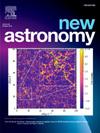WASP-52b:结合新的地面光度观测和TESS观测,结合SOPHIE、COR和HARPS多滤光片光度和光谱径向速度数据,深入了解系外行星的参数
IF 2.1
4区 物理与天体物理
Q2 ASTRONOMY & ASTROPHYSICS
引用次数: 0
摘要
本文分三个步骤进行,(A)系外行星光度观测,(B)利用不同软件和开源平台对原始数据进行光度、径向速度和透射凌日分析,(C)将新的光度数据(我们的观测数据和TESS数据)与径向速度数据结合起来,深入了解这颗行星,并将我们的凌日观测结果与之前发表的和重新分析的结果进行比较。所有这些结果都测试了使用沙迦天文台(SAO- M47)上直径为431毫米的小口径望远镜观测系外行星的能力。为此,我们为WASP-52b系外行星绘制了8条新的光线曲线。2019年和2023年在沙迦天文台(M47, 0.431 m)使用不同的滤光器R、V和l获得观测数据,使用多个软件,通过单独和折叠光曲线分析估计行星凌日的物理和轨道参数,并将凌日结果与EXOFAST工具的径向速度观测相结合,生成依赖滤光器的系外行星的完整参数。首先,我们分别用不同的测光软件和代码(如Muniwin和Hops Master)分析了两种方式的光变曲线,对于折叠的光变曲线我们使用了TransitFit代码。通过光度测量结果,我们确定了行星的半径(R)、半长轴(a)、倾角(i)和凌日时间(P),以便与以往的研究进行比较。为了折叠我们的观测,我们用L滤波器折叠了三个观测,用R滤波器折叠了三个观测,用V滤波器折叠了两个观测。此外,为了比较系外行星的轨道参数,我们依赖于从多源和公共数据档案中收集的不同径向速度观测数据。我们通过收集来自许多天文台档案的开源观测数据,如上普罗旺斯天文台光谱仪(SOPHIE)从2010年到2022年的新发布数据,重新检查、合并和利用(RV)观测数据。HARPS RVBank档案中的HARPS和CORALIE (COR)光谱仪安装在位于La Silla的瑞士1.2米Leonhard Euler望远镜上。利用DACE平台,我们结合数据重新计算和分析了系外行星的质量(Mj),周期(P)和半长轴(a),并将它们与我们的两种软件(HOPS和TransitFit)结果产生的光度结果进行了比较。此外,我们重新分析了2017年对WASP-52b系外行星的透射过境观测数据,以了解多滤观测结果之间的过境深度差异。为此,我们使用了行星大气传输(PLATON)代码,通过多滤波器观测来估计行星的大小,以表征影响行星过境深度的大气特征,并绘制了NASA系外行星档案/大气光谱平台中列出的所有先前传输数据。2024年11月下旬,TESS档案发布了14次新的WASP-52b凌日数据。这些凌日被用来重新评估系外行星的参数,将它们与之前发表的结果和作者之前的发现进行比较。分析包括调查WASP-52b的凌日时间变化(TTV),以探索这颗行星受到看不见的伴星影响的可能性。此外,进行这些测试是为了评估小口径431毫米望远镜对具有类似性质的系外行星进行可靠和准确测量的能力。在本研究中,我们利用折叠P的结果,尝试按照线性或二次模型来确定轨道模型。我们使用这两个模型的方程来计算我们观测到的所有2023年凌日的新时代的拟合周期。两个方程的结果进行了比较,显示出与线性模型更接近的匹配,并证实了行星旋转周期的稳定性。我们的分析发现,对于L、V和R滤波器,Rp/R*分别= 0.15415、0.16366和0.164985。为了更好地理解L滤光器结果之间的差异,并确定滤光器之间交叉深度差异的原因,很明显,通过L滤光器范围的光量大于宽频带光度观测中行星尺寸减小所显示的光量。图4中的过滤器比较说明了这一点。最后,光度和光谱的周期结果分别为:滤波器L的P = 1.7497788,滤波器V的P = 1.7497807,滤波器R的P = 1.7497782,同阶a/R*分别= 7.363,7.408,7.521。对来自SAO和TESS的所有数据的分析都是在自由偏心率的假设下进行的,以确定行星轨道是否存在椭圆性。本文章由计算机程序翻译,如有差异,请以英文原文为准。
WASP-52b: Insights into the exoplanet’s parameters from combining new photometric ground observations and TESS observation with SOPHIE, COR, and HARPS data for multifilter photometric and spectroscopic radial velocity
This paper is done in three steps, (A) exoplanet photometric Observation, (B) photometric, radial velocity, and transmission transit analysis by the RAW data with different software and open-source platforms, and (C) combines new photometric data (our observations and TESS data) with radial velocities data to bring insights into this planet, to compare our transit observations results with previously published and reanalyzed results. All these results test the ability of exoplanet observations using a small telescope aperture hosted in Sharjah Astronomical Observatory (SAO- M47) with a 431 mm diameter.
For that, we made eight new light curves for the WASP-52b exoplanet. The observations were obtained from the Sharjah Astronomical Observatory (M47, 0.431 m) during 2019 and 2023 using different filters R, V, and L. Using multiple software, we estimated the planet transit’s physical and orbital parameters from individual and folded light curves analysis and apply transit results with radial velocity observation by EXOFAST tool for generate the full parameters of the exoplanet depend on filters. First, we analyzed light curve transits in two ways, individually with different photometrical software and codes like Muniwin and Hops Master, for folded light curves we applied the TransitFit code. By photometric results, we have determined the radius of the planet (R), semi-major axis (a), inclination (i), and period of transit time (P) for comparison with previous studies. For folded our observations, where we folded three observations by the L filter, three observations by the R filter, and two observations by the V filter. Also, for comparing exoplanet orbit parameters we relied upon different radial velocity observations collected from multi-source and public data archives we reexamined, merged, and utilized (RV) observation data by collecting open-source observations from many observatories archives like the Haute-Provence Observatory spectrograph (SOPHIE) new release data starting from 2010 to 2022, HARPS from HARPS RVBank archive and CORALIE (COR) spectrograph installed at The Swiss 1.2-metre Leonhard Euler Telescope at La Silla. Using the platform DACE we recalculate and reanalyze the Mass (M), Period (P), and semi-major axis(a) of the exoplanet after combining the data and compare them with our photometric results generated by both software ( HOPS and TransitFit) results. Moreover, we reanalyzed the transmission transit observation data for the WASP-52b exoplanet taken in 2017 to comprehend the difference in transit depth between multifilter observation results. For that, we employed the PLanetary Atmospheric Transmission for Observer Noobs (PLATON) code to estimate the planet’s size with multi-filter observations for characterizing the atmospheric features that would affect the planetary transit depth and plot all previous transmission data listed in the NASA Exoplanet Archive/ Atmospheric Spectroscopy platform. In late November 2024, the TESS archive released data for 14 new transits of WASP-52b. These transits were utilized to re-evaluate the exoplanet parameters by comparing them to previously published results and the authors’ prior findings. The analysis included investigating the transit-timing variation (TTV) of WASP-52b to explore the possibility of the planet being influenced by an unseen companion. Furthermore, these tests were conducted to assess the capability of a small-aperture 431 mm telescope to produce reliable and accurate measurements for an exoplanet with similar properties. By using folded P results in this study, We try to determine the orbit model by following a linear or quadratic model. We use the equations of both models to calculate the fit period for the new Epochs we observed for all 2023 transits. The results from both equations were compared, showing a closer match with the linear model and confirming the stability of the planet’s rotational period. Our analysis found that Rp/R* = 0.15415, 0.16366, and 0.164985 for the L, V, and R filters respectively. To better understand the difference between the results of the L filter and to identify the reason for the variance in the depth of the crossing between the filters, it became apparent that the amount of light passing through the range of the L filter is greater than what is indicated by the decrease in the size of the planet in wide band photometric observations. This is illustrated by comparing the filters in the Figure 4. Finally, the period results from photometric and spectroscopic are shown as follows P of filter L= 1.7497788, P of filter V= 1.7497807, P of filter R= 1.7497782 respectively, in the same order a/R*= 7.363, 7.408, 7.521 respectively. All analyses of the data from SAO and TESS were performed under the assumption of free eccentricity to determine whether any ellipticity is present in the planet’s orbit.
求助全文
通过发布文献求助,成功后即可免费获取论文全文。
去求助
来源期刊

New Astronomy
地学天文-天文与天体物理
CiteScore
4.00
自引率
10.00%
发文量
109
审稿时长
13.6 weeks
期刊介绍:
New Astronomy publishes articles in all fields of astronomy and astrophysics, with a particular focus on computational astronomy: mathematical and astronomy techniques and methodology, simulations, modelling and numerical results and computational techniques in instrumentation.
New Astronomy includes full length research articles and review articles. The journal covers solar, stellar, galactic and extragalactic astronomy and astrophysics. It reports on original research in all wavelength bands, ranging from radio to gamma-ray.
 求助内容:
求助内容: 应助结果提醒方式:
应助结果提醒方式:


